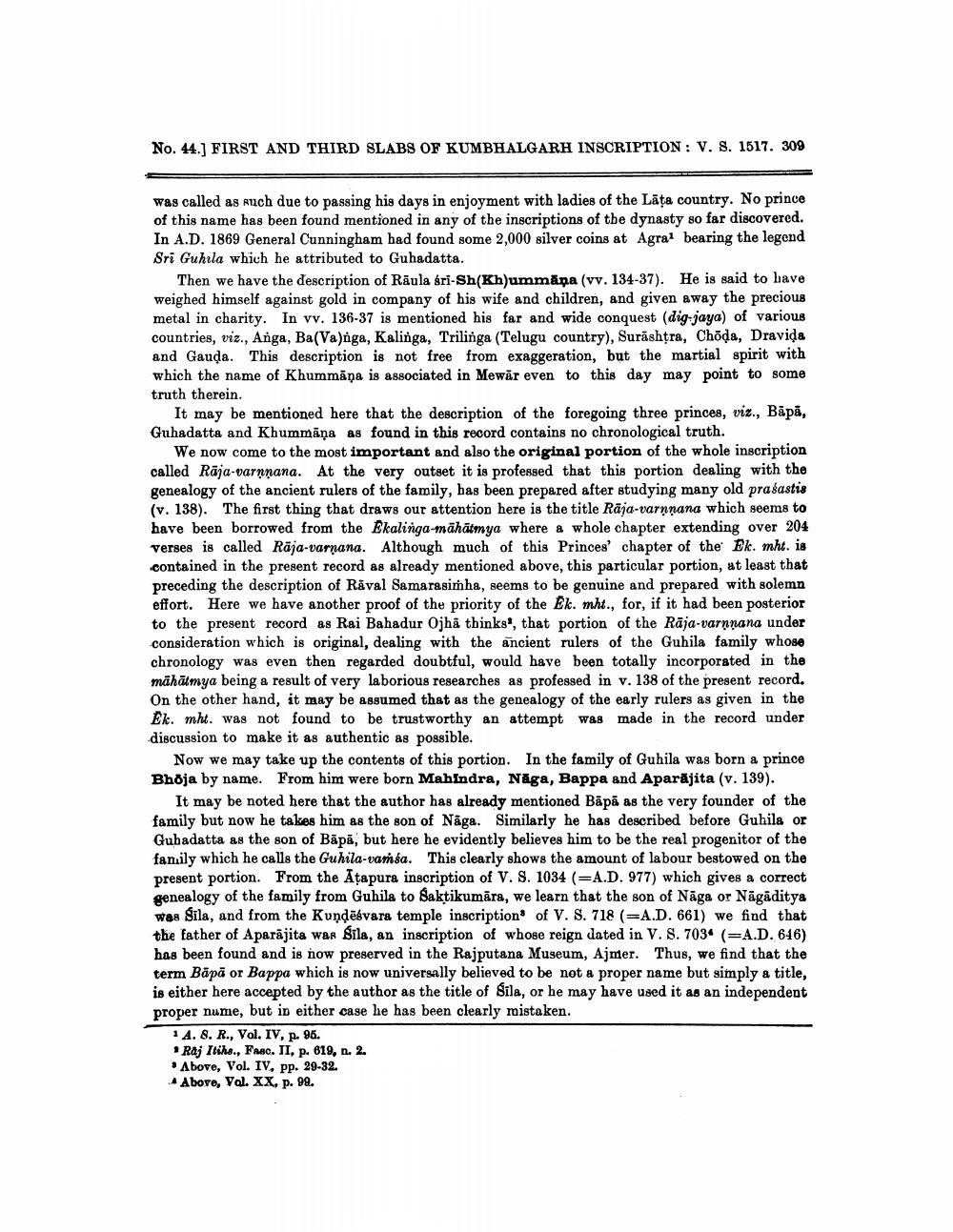________________
No. 44.) FIRST AND THIRD SLABS OF KUMBHALGARH INSCRIPTION: V. S. 1517. 309
was called as such due to passing his days in enjoyment with ladies of the Lāța country. No prince of this name has been found mentioned in any of the inscriptions of the dynasty so far discovered. In A.D. 1869 General Cunningham had found some 2,000 silver coins at Agral bearing the legend Sri Guhula which he attributed to Guhadatta.
Then we have the description of Räula sri-Sh(Kh)ummapa (vv. 134-37). He is said to have weighed himself against gold in company of his wife and children, and given away the precious metal in charity. In vv. 136-37 is mentioned his far and wide conquest (dig jaya) of various countries, viz., Anga, Ba(Vanga, Kalinga, Trilinga (Telugu country), Surāshtra, Choda, Dravida and Gauda. This description is not free from exaggeration, but the martial spirit with which the name of Khummāna is associated in Mewar even to this day may point to some truth therein.
It may be mentioned here that the description of the foregoing three princes, viz., Bāpā, Guhadatta and Khummāna as found in this record contains no chronological truth.
We now come to the most important and also the original portion of the whole inscription called Rāja-varnnana. At the very outset it is professed that this portion dealing with the genealogy of the ancient rulers of the family, has been prepared after studying many old prasastis (v. 138). The first thing that draws our attention here is the title Rāja-varnnana which seems to have been borrowed from the Ekalinga-māhātmya where a whole chapter extending over 204 verses is called Räja-varnana. Although much of this Princes' chapter of the Ek. mht. is .contained in the present record as already mentioned above, this particular portion, at least that preceding the description of Raval Samarasimha, seems to be genuine and prepared with solemn effort. Here we have another proof of the priority of the Ek. mht., for, if it had been posterior to the present record as Rai Bahadur Ojhả thinks', that portion of the Rāja-varnnana under consideration which is original, dealing with the ancient rulers of the Guhila family whose chronology was even then regarded doubtful, would have been totally incorporated in the māhātmya being a result of very laborious researches as professed in v. 138 of the present record. On the other hand, it may be assumed that as the genealogy of the early rulers as given in the Ek. mht. was not found to be trustworthy an attempt was made in the record under discussion to make it as authentic as possible.
Now we may take up the contents of this portion. In the family of Guhila was born a prince Bhoja by name. From him were born Mahindra, Näga, Bappa and Aparājita (v. 139).
It may be noted here that the author has already mentioned Bāpā as the very founder of the family but now he takes him as the son of Nāga. Similarly he has described before Guhila or Gubadatta as the son of Bāpā, but here he evidently believes him to be the real progenitor of the family which he calls the Guhila-vaṁsa. This clearly shows the amount of labour bestowed on the present portion. From the Atapura inscription of V. S. 1034 (=A.D. 977) which gives a correct genealogy of the family from Guhila to Saktikumāra, we learn that the son of Nāga or Nägāditya was Sila, and from the Kundēsvara temple inscription of V. S. 718 (=A.D. 661) we find that the father of Aparajita wan Sila, an inscription of whose reign dated in V. S. 703* (=A.D. 616) has been found and is now preserved in the Rajputana Museum, Ajmer. Thus, we find that the term Bāpā or Bappa which is now universally believed to be not a proper name but simply a title, is either here accepted by the author as the title of Sila, or he may have used it as an independent proper nume, but in either case he has been clearly mistaken. 1A. 8. R., Vol. IV, p. 96.
Raj Itihs., Fasc. II, p. 619, n. 2. . Above, Vol. IV, pp. 29-32. Above, Val. XX, p. 99.




